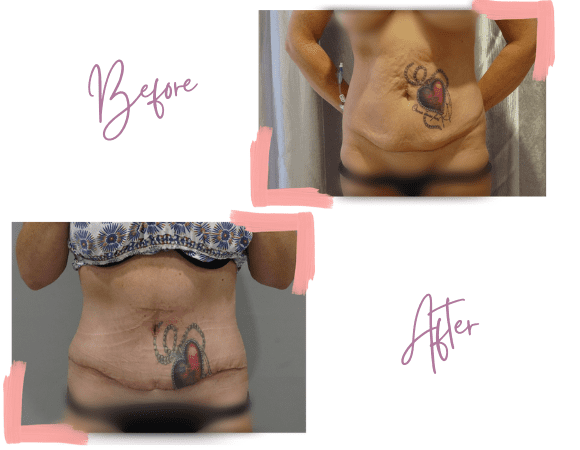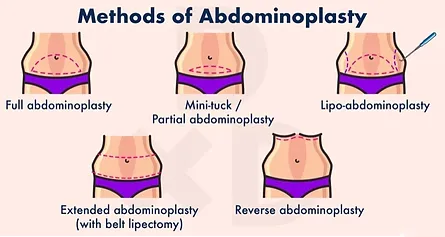Tummy Tuck
Sometimes diet and exercise aren't enough. Get the tummy you've always dreamt of.
Your Tummy Tuck Package Includes:
- Hospital Stay In A Single Private Room + Theatre + Pathology
- Australian Client Manager
- Surgery + Plastic Reconstructive Surgeon + Anaesthetist + Nursing Fees + Hospital Fees
- Bandages, Dressings + Prescribed Medications for 7 Days
- Pre + Post Operative Consultations with Our Surgeon
- Zoom Calls + Photo Checkups with Surgeon for 12 months
- Airport, Hotel and Hospital Transfers Included
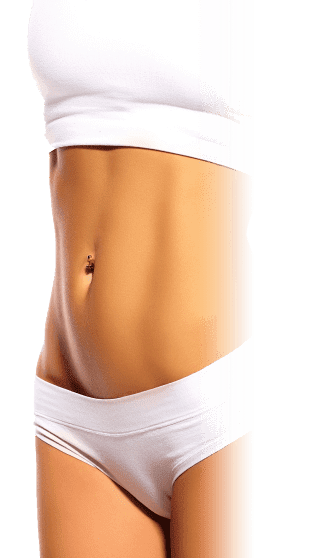
- Full, Mini, Extended and Reverse
- Circumferential Lift
- Fleur De Lis Lift
”Wonderful expereince and results so far! The entire staff of Medi Makeovers and Dr. Teerapat are super friendly
VanessaTummy Tuck
What is Tummy Tuck?
Female and Male Abdominoplasty or “tummy tuck” is a procedure used to make the abdomen thinner and more firm. The surgery involves the removal of excess skin and fat from the middle and lower abdomen, and tightening of the muscle and fascia of the abdominal wall. This type of surgery is usually sought by patients with loose or sagging tissues after pregnancy or major weight loss. There are several types of Tummy surgery that can be performed – see diagrams below. Our surgeon will advise you with a personal assessment, which is best for you, from your personal photos and medical form information. Full, Mini, and Extended Tummy Tucks, Fleur De Lis Tummy Tuck,s and Circumferential lifts are all performed by our surgeons.
A Tummy Tuck is done when:
-
Pregnancy has made the muscles lose, excess skin, and stomach skin sag
-
Weight loss has created excess skin and made the stomach skin sag
-
Hereditary issues cause excess skin
Am I Good Candidate
One or more of the following feelings or conditions may indicate that you are a good candidate for a Tummy Tuck:
-
You are physically healthy and at a stable weight
-
You have realistic expectations
-
You are a non-smoker
-
You are bothered by the appearance of your abdomen
-
You’ve got flab, stretch marks or excess skin in your abdomen that does not improve with diet or exercise
-
If the shape of your abdomen has been affected by pregnancy or massive weight loss
Procedure Details
 The type of ‘tuck‘ you will require will be determined by your surgeon. Scarring is different for everyone as not everyone has excess skin in the same places.
The type of ‘tuck‘ you will require will be determined by your surgeon. Scarring is different for everyone as not everyone has excess skin in the same places.
With our hospitals, these procedures are only performed under general anaesthetic. The length of the operation will depend on the extent of the surgery, but the surgeon will advise you of the length of the surgery during your consultation. Generally speaking, this surgery involves:
- Specific cut relevant to the type of abdominoplasty agreed is needed (see below)
- The skin and fatty tissue are lifted from the underlying tissue.
- The surgeon will stitch and tighten slack or separated abdominal muscles.
- Excess fat is removed.
- Excess skin is trimmed.
- The navel is repositioned.
- The wounds are closed with stitches, tape or clips.
Full Tummy Tuck
This is the most commonly performed type of tummy tuck surgery. This involves the creation of a hip-to-hip incision, as well as incisions around the belly button. Because they address the patient’s entire abdominal area, they often involve ‘creating’ a new belly button to ensure natural looking results. Abdominal liposuction is commonly added to this procedure.
Mini Tummy Tuck
Also called partial abdominoplasties, are intended for patients who are within 10 percent of their ideal body weight and are content with making alterations only to the part of the abdomen that is below the navel. Mini tummy tucks require only a single small incision. They usually do not involve repositioning the navel. Partial abdominoplasties result in less dramatic changes to the appearance of the abdomen than other types of abdominoplasty surgery, but also offer a shorter recovery time than most tummy tuck procedures.
Extended Tummy Tuck
Involves the removal of ‘love handles’ on either side of the waist as well as the removal of fat and excess skin from the stomach area. The incision is longer to remove excess skin and avoid ‘Dog Ears’ and is usually low so that even if the scar extends behind the hips, it will not be visible, even when one is wearing low-rise clothing. This procedure allows for the treatment of a larger area than the traditional tummy tuck. In order to address the lifting of the entire lower body area, a circumferential tummy tuck is usually required.
Circumferencial Tuck
The Circumferential Body Lift procedure is performed to correct many of the areas of loose skin after massive weight loss from diet and exercise or from having had weight loss surgery. When a person loses a lot of weight, the skin cannot adequately shrink due to poor tissue elasticity. Skin hangs and droops, creating uneven contours. No amount of exercise or dieting will make the excess skin go away. Surgery is required to remove the excess loose skin thus improving the shape and tone of the underlying tissue that supports fat and skin.
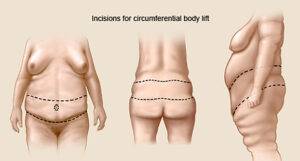 A circumferential body lift procedure removes a belt of skin, subcutaneous fat and tissue in the abdomen, skin in the waist and buttock areas, resulting in a smoother, more youthful body contour. These physical changes to the body can improve your body image and enhance self-confidence. A circumferential incision is 360 degrees around your body i.e. around the abdominal area, extending around the sides and into the lower back is used to remove excess skin and fat and reposition and tighten tissues. The result leaves a single scar around the body.
A circumferential body lift procedure removes a belt of skin, subcutaneous fat and tissue in the abdomen, skin in the waist and buttock areas, resulting in a smoother, more youthful body contour. These physical changes to the body can improve your body image and enhance self-confidence. A circumferential incision is 360 degrees around your body i.e. around the abdominal area, extending around the sides and into the lower back is used to remove excess skin and fat and reposition and tighten tissues. The result leaves a single scar around the body.
Fleur De Lis Lift
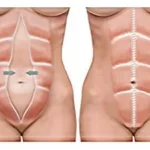 This involves an incision running laterally across the abdomen, from one hip to the other, just above the pubic bone, and this procedure utilizes an additional incision, running vertically down the midsection, to better address the lax abdominal tissue. This is for clients who have very large amounts of excess skin and need more than an Extended Tummy Tuck. If you have experienced a significant weight loss, this may be the procedure for you – this will restore a smooth, curvaceous figure as it also addresses the upper abdomen as well.
This involves an incision running laterally across the abdomen, from one hip to the other, just above the pubic bone, and this procedure utilizes an additional incision, running vertically down the midsection, to better address the lax abdominal tissue. This is for clients who have very large amounts of excess skin and need more than an Extended Tummy Tuck. If you have experienced a significant weight loss, this may be the procedure for you – this will restore a smooth, curvaceous figure as it also addresses the upper abdomen as well.
Reserve Tummy Tuck
This procedures involves incisions at the top of the upper abdomen – just near or at the breast crease. This is usually done possibly after a full tummy tuck has been done previously and you have either lost more weight, or you may just have excess skin on the upper abdomen only. See diagram above. It may also possibly involve tightening of the abdominal muscles.
Your Recovery + After Care
When you wake up after tummy tuck surgery, your abdomen may be very swollen and it may be throbbing. Don’t wait for pain to be unbearable before you take your pain medication. Take your pain medication on time because that stops the pain before it gets too bad. You will actually use less pain medication if you take it on time than if you wait for the pain to become severe. And pain interferes with healing. There is absolutely no reason to be tough and suffer through the pain. As the days go on the swelling and pain will dissipate. You may have bruising, but this is normal. Abdominoplasty involves loosening the skin from its previous attachments and re-draping it. That action, along with the incisions, means that some nerves were cut. Sensation will usually come back gradually over the course of several months. Sometimes, the first thing you will feel in areas that were numb is itchiness or tingling.
Sleep with your head and shoulders elevated for the 14-21 days. You will be laying down a lot because you will be sore and will have problems standing upright for at least one month. Sitting may be more comfortable, but still might be a bit much for you. Sleeping may not be a problem, since some pain medications can make you sleepy. Getting up and down from a sitting position or in and out of bed will be difficult and will hurt. Remember, everything will continue to get easier as the days pass. Full recovery after tummy tuck could be several months.
You MUST Wear Compression Garments
Our surgeons require you to wear a compression garment around your abdomen. You MUST wear this compression garment for a minimum of three months – it is a good idea to purchase two or three garments so you can wash and wear. This may be in the form of a wide binder that goes around your abdomen or a girdle-like garment that pulls on or zips up the side. Either will compress your abdomen a bit and help in healing and controlling the swelling.
We encourage you to walk around after you leave the hospital, so this is where you can take short trips to do some shopping, light sightseeing or you might want to just go out to lunch or dinner. Do not go outside in the heat and do too much sightseeing as this will cause more swelling and you may develop infections. This is a great time to have pampering, foot and leg massages, facials, pedicures etc – not the time to visit Temples etc. Please listen to your body and do not overdo it, it is very important to rest during your recovery from surgery. When you return home, please take it very easy and do light duties and do not pick up objects for about 2 months as this can put pressure on the stitches internally and externally. A few weeks after surgery, sutures used to close the deeper layers may spontaneously surface through the skin. Although these are expected to be absorbed within 4-6 months following surgery, these are still material foreign to the body and may be “pushed outwards” as healing continues. This can become visible or produce irritation and removal may be required. You may be able to remove these yourself or please see your local GP and they can remove them.
General Risks of Abdominoplasty Surgery
There are risks associated with all surgery, and following your surgeons instructions will help to reduce these. The most common risks include:
Bad Reaction to Anaesthesia
General anaesthesia, used during abdominoplasty surgeries, is considered slightly more risky than local anaesthesia. It can cause an unpleasant or unexpected reaction; however, a qualified anaesthesiologist should be able to identify emerging problems before they become worse.
Blood Clots
Blood clotting is the body’s natural way of controlling the amount of blood that is lost after an injury, but depending on their location, they can be dangerous. If a blood clot forms inside a blood vessel, it may complicate your circulation. If a blood clot travels to your lungs, brain, or heart, the result can be deadly.
Decreasing Your Risk of Blood Clots
There are several things you can do to decrease the risk of blood clots, prior to surgery. First, be completely honest in your medical history and other information you provide to your doctor. Be sure to give your doctor a list of all medications you take prior to the surgery. This will help your doctor determine if you are at an increased risk of developing blood clots following surgery. If you take birth control pills, you may want to discontinue their use during the preparation and recovery from tummy tuck surgery – talk to your doctor about this possibility before doing so.
After surgery, and during your recovery, most surgeons advise using compression stockings, pre- or post-operative leg massage, and short walks within a day or two of your surgery. Gentle movement is helpful and will speed your recovery, but too much exertion or vigorous activity can be detrimental.
Infection
Tummy tuck patients are at risk of developing an infection during and immediately following their surgery. A clean, sterile, operating room lessens the risk of contracting an infection during the surgery.
After surgery, the risk of infection increases if the surgical wound is not properly cared for. Your surgeon will have specific instructions for removing/changing bandages, exposing your wound to water, and keeping it clean. Note that it is normal to have some bleeding and leakage after surgery, but if the surgical wound is unclean, the risk of infection rises. Most infections following tummy tuck surgery are the result of the patient’s failure to properly care for their surgical wound during their recovery.
Fluid Accumulation
Most tummy tuck patients need drains after their procedure. The drains decrease the risk of seroma formation (i.e., fluid collecting between the muscle layer and the skin flap), which can cause infection. The drains create a point of exit for this fluid, reducing the risk of infection following tummy tuck surgery.
Slow Healing
Each patient will heal at his or her own pace. That being said, young patients in good physical condition typically heal faster than older or less physically fit patients. Tenderness, bruising, pain, and swelling usually subside after about four to six weeks. Patients who experience significant discomfort after six weeks have passed are considered to be healing slowly.
Smoking or exposure to cigarette smoke decreases the size of blood vessels, complicating circulation of oxygen to the skin cells.
Other risks include:
-
Skin loss
-
Numbness or other changes in skin sensation
-
Skin discoloration and/or prolonged swelling
-
Unfavourable scarring
-
Recurrent looseness of skin
-
Fatty tissue found deep in the skin might die (fat necrosis)
-
Deep vein thrombosis, cardiac and pulmonary complications
-
Asymmetry
-
Suboptimal aesthetic result
-
Possibility of revision surgery
-
Persistent pain
Client Testimonials
Types of Tummy Tuck Surgery
The type of ‘tuck’ you will require will be determined by your surgeon. Scarring is different for everyone, as not everyone has excess skin in the same places.
Full Tummy Tuck
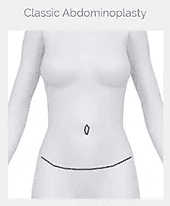 This is the most commonly performed type of tummy tuck surgery. This involves the creation of a hip-to-hip incision, as well as incisions around the belly button.
This is the most commonly performed type of tummy tuck surgery. This involves the creation of a hip-to-hip incision, as well as incisions around the belly button.
- Addresses the patient’s entire abdominal area.
- Often involves ‘creating’ a new belly button to ensure natural-looking results.
- Abdominal liposuction is commonly added to this procedure.
Mini Tummy Tuck
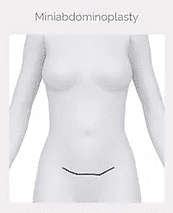 Also called partial abdominoplasties, this procedure is intended for patients who are within 10 percent of their ideal body weight and are content with making alterations only to the part of the abdomen that is below the navel.
Also called partial abdominoplasties, this procedure is intended for patients who are within 10 percent of their ideal body weight and are content with making alterations only to the part of the abdomen that is below the navel.
- Mini tummy tucks require only a single small incision.
- They usually do not involve repositioning the navel.
- Partial abdominoplasties result in less dramatic changes to the appearance of the abdomen.
- Shorter recovery time than most tummy tuck procedures.
Extended Tummy Tuck
Involves the removal of ‘love handles’ on either side of the waist as well as the removal of fat and excess skin from the stomach area. The incision is usually low so that even if the scar extends behind the hips, it will not be visible, even when one is wearing low-rise clothing.
- This procedure allows for the treatment of a larger area than the traditional tummy tuck.
- In order to address the lifting of the entire lower body area, a circumferential tummy tuck is usually required.
Circumferential Lift
BELT LIPECTOMY
The Circumferential Body Lift procedure is performed to correct many of the areas of loose skin after massive weight loss from diet and exercise or from having had weight loss surgery. When a person loses a lot of weight, the skin cannot adequately shrink due to poor tissue elasticity. Skin hangs and droops, creating uneven contours. No amount of exercise or dieting will make the excess skin go away. Surgery is required to remove the excess loose skin, thus improving the shape and tone of the underlying tissue that supports fat and skin.
- A circumferential body lift procedure removes a belt of skin, subcutaneous fat, and tissue in the abdomen and skin in the waist and buttock areas.
- These physical changes to the body can improve your body image and enhance your self-confidence.
- A circumferential incision around the abdominal area, extending around the sides and into the lower back, is used to remove excess skin and fat and reposition and tighten tissues.
- The result leaves a single scar around the body.

Fleur De Lis Lift
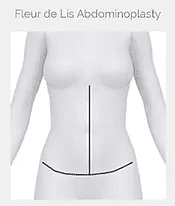 This involves an incision running laterally across the abdomen, from one hip to the other, just above the pubic bone, and this procedure utilizes an additional incision, running vertically down the midsection, to better address the lax abdominal tissue.
This involves an incision running laterally across the abdomen, from one hip to the other, just above the pubic bone, and this procedure utilizes an additional incision, running vertically down the midsection, to better address the lax abdominal tissue.
- This is for clients who have very large amounts of excess skin and need more than an Extended Tummy Tuck.
- If you have experienced significant weight loss, this may be the procedure for you.
- This will restore a smooth, curvaceous figure as it also addresses the upper abdomen as well.
Reverse Tummy Tuck
This procedure involves incisions at the top of the upper abdomen – just near or at the breast crease. This is usually done possibly after a full tummy tuck has been done previously, and you have either lost more weight or you may just have excess skin on the upper abdomen only. See the diagram here.
- It may also possibly involve tightening of the abdominal muscles.
- The incision is across the top of the upper abdomen.
What To Expect?
Once you have submitted your surgery medical form and photos – our team will arrange a free assessment, and outline all the details you will need to know about the Surgery Price, Length of Stay in Bangkok, Hotel, Transfers, and much more.
Payment Plans
Don’t have all the funds ready for your surgery or dental trip? Medi Makeovers have partnered with Australia’s leading financial service to offer our clients finance for all aspects of their medical holiday – even spending money.
TLC Credit Benefits
TLC provides a payment plan solution to suit your lifestyle and has been designed to cover all medical, cosmetic and lifestyle needs as well as your associated costs.
- Payment plans up to $50,000 – including treatment / flights & accommodation
- No stress – the whole process is managed privately by our Consultants
- Flexible options – any additional repayments can be added back on to the payment plan at no extra charge
- Fast efficient approvals, simply apply online
TLC offers a simple and personal solution to customers, where they personalise the experience to suit customer expectations and desires to ensure a smooth transaction. Finance can be arranged to cover not only the cost of overseas procedures, but also all associated travel costs including spending money.

Five Star Recovery
Bangkok is the perfect destination for your surgery and/or dental trip as most attractions, shopping malls and transportation are air conditioned and away from the warm climate of Thailand. This is particularly important for your post-op recovery after surgery. Our hotels are located in the best parts of town, away from the nightlife – yet close to all major shopping centres (you can walk to them!), massages, hair salons and beauty salons so you can have the best possible recovery and indulge a little!

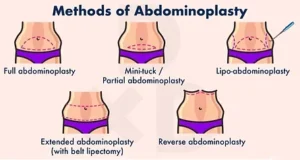 The type of ‘tuck‘ you will require will be determined by your surgeon. Scarring is different for everyone as not everyone has excess skin in the same places.
The type of ‘tuck‘ you will require will be determined by your surgeon. Scarring is different for everyone as not everyone has excess skin in the same places.